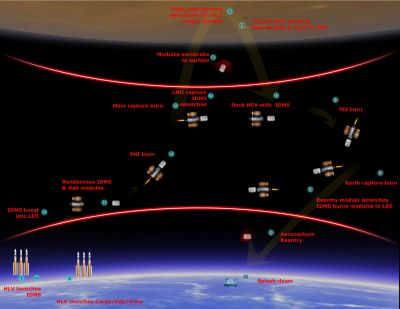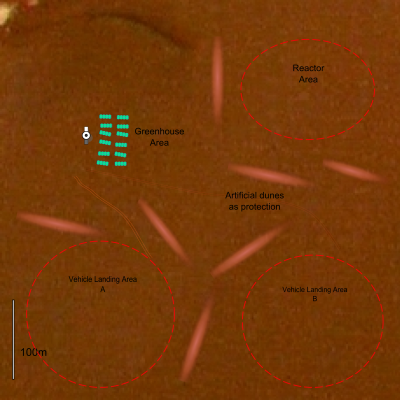OFMM
Orbiter Forum Mars Mission (OFMM) codenamed: Prometheus is, a project undergone by Orbiter Forum members that will simulate a mission to Mars using future realistic technology.
Mission
First and foremost, establish habitation areas for astronauts. Second, start production of fuel for vessels. Third, start scientific gatherings (resource collection)
| #Objective | Description |
|---|---|
| O10000 | Establish habitation area for 20 astronauts |
| O20000 | Produce propellants in-situ for four lift-offs per season |
| O30000 | Locate water ice |
| O30001 | Locate suitable minerals for producing propellants. |
| O30002 | Locate suitable minerals for in-situ concrete production. |
| O30003 | Establish a grid network of permanent weather stations on Mars. |
Primary Vessels
IDMS (Independent Detachable Maneuvering System)
- Proposed vehicle ( Nerva2 )
This system will be the rocket engine that will send vehicles and vessels to Mars. Once cargo has obtained LMO (low Mars orbit) IDMS will serve as the propulsion system from transportation from Mars to Earth and back.
HCV (Heavy Cargo Vessel)
- Proposed vehicle ( pending,
Arrow)
This vessel is primarily used as cargo transportation between the Martian surface and LMO. This vessel will mostly stay in LMO and on Mars.
SMEV (Small Mars Exploration Vehicle)
- Proposed vehicles ( Viking, custom design lander,
DGIV, XR2)
These smaller vessels will be used as exploration vehicles that will allow ground crew astronauts explore a much larger radius of Mars.
OSHV (Orbital and Surface habitation vessel)
- Proposed vehicles ( pending )
This module is the primary vessel where the crew will live and work during the entire mission. This module needs to be able to aerobrake and land on Mars. Support several crew for at least 2 years (with the help of service modules ext)
Design options:
- Environmental Control and Life Support Subsystem (ECLSS)
- Electrical Power Subsystem
- Power generation
- Power storage
- Landing system
- Integrated landing system
- External landing system
- Skycrane
- With inflatable heat shield
- with rigid heat shield
- Skycrane
MRCS (Mars Radio Communications System)
- Proposed vehicles ( DGIV's COM satellite, Carina2 ) -pending use
These smaller vessels will be signal relay vessels for Mars ground crew. Note: useless to have a com relay system if we have an interplanetary craft in orbit already ready to relay signals.
Science projects & Experiments
MSEP (Mars surface Experiments Package)
- Central Station
- Radioisotope Thermoelectric Generator (RTG)
- RTG Cask
- pending additional experiments
Ground Operations
- Shelter
- Hab module
- Additional Living space
- Inflatables?
- underground?
- Cargo Storage areas
- ECLSS
- Food/Water
- Storage area
- Creation / refinement / purification (part of ECLSS)
- ...or bring along or combination of both
- Heat
- Electric or reuse of waste heat from RTG
- Communication
- High-gain/low gain antennas
- Relay station (ground - LMO - Earth) (I doubt we can continue working off an aging satellite for long)
- Power generation
- big RTG or single SNAP-10A
- Depending on power requirements, multiple 'stations' for additional power.
- big RTG or single SNAP-10A
- Equipment for construction/moving cargo ext
- Forklift?
- Electric truck?
- Bulldozer? (or are we going to 'fake it?' I vote so)
- Work Tools (container anyway)
- wrenches, hammers, shovels, ext ext can be put in a deploy able UCGO cargo, which could deploy into a work bench & tool shelves ext.
- Medical
- Med cargo
- possible surgery equipment? (medical module, orbit only, the rest can be done in a building/inflatable bay with med tool cargo)
- Rocket Fuel production/storage
- Above ground drums or cylinders (like propane tanks)
- underground fuel containers (gas station style)
General Mission Plan
1. Build (model required vessels)
2. Transfer to Mars orbit
3. Land hauler and crew on Martian surface.
4. Begin building habitation area.
5. Begin building propellant resource collection
1. Fuel up hauler/vehicles if applicable
6. Start resource/cargo production/research
7. When Mars-Earth launch window approaches, launch cargo/resources to Earth
1. If crew is getting rotated, they ride along with the cargo containers.
Roles and Responsibilities
* Cargo Manager - Bj so far
o Manages Miner and the miners productions (cargo)
o Manages cargo placement & storage
o Manages cargo hauler (limited to sub orbital flights only)
* Launch Manager
o Manages any vehicle launching to, or returning from space.
o Manages launch equipment
o Controls unmanned/manned vehicles in space
* Ground Expedition Manager - Bloodworth
o Manages all vehicles, equipment and UMMU on the ground at any time.
o Designs habitual base camps for UMMU(camp layout, and/or possibly camp modeling)
o Responsible for the exploration of Mars,scientific equipment, and locating resources
Technological Disparities
Currently UMMU destabilizes at any simulated year past ~2040. In consequence, this project is required to start within recent time frames (ie 2010 - 2015) so that the project can progress for a while. Many OF members dispute the technological advances between these years, as the Arrow is considered slightly above our technological capability for the next several decades. As it is, there are no vessels currently operating within Orbiter, so for now unless several someones creates a more realistic vessel capable of the job, we have to stick with what we have.
Current Developments
Some of the systems required by this project haven't been implemented yet. In consequence, there are several parts that need to be developed before we get too far into the mission.
- Developer: [empty] Mining
The mining and propellant creation is vital to this missions survival, otherwise vessels on Mars will have to carry all their propellant from Earth, and can only use it sparingly.
- Developer: [empty] Cargo creation
From the manufacturing of materials, there will need to be UCGO cargo with the proper textures of its contents. Since there is a vast amount of elements, many textures will have to be made.
- Developer: [empty] Sampler
Since it would be rather difficult to drag the actual drill around to find deposits (especially when that drill is in use), a vehicle capable of taking samples from the ground and analyzing it for its contents needs to be created to assist ground exploration. This will need to use the SDK that will be provided from the Mining module.
Models & textures
- Developer: [empty] Models of Fuel tanks
- Developer: [empty] Model of a proposed plaque to put over resting spot of MER vehicle Spirit.
- Developer: [Columbia42] Models of the Hab center
- Developer: [empty] Models of the reactor
- Developer: [Bj] Models of the 'Sand dunes'
- Developer: [empty] Models of future science experiments (possibly programs too)
- Developer: [Pablo49] Models of greenhouse
- Deployable cargo
- Tools/workbenches (many different boxes, as you are limited to UCGO size box.)
- Fuel tanks
- Greenhouses
- Antennas
- Power -RTG or SNAP-10A. (I vote SNAP)
- Hab modules
- Water bins/storage purification
- Static (for looks) cargo
- Medical cargo
- Medical tools
- Medical computers/instruments (whatever you call em)
- Tool containers
- Drums/containers for fuel
- UCGO vehicle
- Forklift
UCGO static cargo Textures(& configs?)
- Developer: [empty] Lithium = 3
- Developer: [empty] Beryllium = 4
- Developer: [empty] Boron = 5
- Developer: [empty] Carbon = 6
- Developer: [empty] Sodium = 11
- Developer: [empty] Magnesium = 12
- Developer: [empty] Aluminum = 13
- Developer: [empty] Silicon = 14
- Developer: [empty] Phosphorus = 15
- Developer: [empty] Sulfur = 16
- Developer: [empty] Potassium = 19
- Developer: [empty] Calcium = 20
- Developer: [empty] Scandium = 21
- Developer: [empty] Titanium = 22
- Developer: [empty] Vanadium = 23
- Developer: [empty] Chromium = 24
- Developer: [empty] Manganese = 25
- Developer: [empty] Iron = 26
- Developer: [empty] Cobalt = 27
- Developer: [empty] Nickel = 28
- Developer: [empty] Copper = 29
- Developer: [empty] Zinc = 30
- Developer: [empty] Gallium = 31
- Developer: [empty] Germanium = 32
- Developer: [empty] Arsenic = 33
- Developer: [empty] Selenium = 34
- Developer: [empty] Bromine = 35
- Developer: [empty] Rubidium = 37
- Developer: [empty] Strontium = 38
- Developer: [empty] Yttrium = 39
- Developer: [empty] Zirconium = 40
- Developer: [empty] Niobium = 41
- Developer: [empty] Molybdenum = 42
- Developer: [empty] Technetium = 43
- Developer: [empty] Ruthenium = 44
- Developer: [empty] Rhodium = 45
- Developer: [empty] Palladium = 46
- Developer: [empty] Silver = 47
- Developer: [empty] Cadmium = 48
- Developer: [empty] Indium = 49
- Developer: [empty] Tin = 50
- Developer: [empty] Antimony = 51
- Developer: [empty] Tellurium = 52
- Developer: [empty] Iodine = 53
- Developer: [empty] Caesium = 55
- Developer: [empty] Barium = 56
- Developer: [empty] Lanthanum = 57
- Developer: [empty] Platinum = 78
- Developer: [empty] Gold = 79
- Developer: [empty] Mercury = 80
- Developer: [empty] Thallium = 81
- Developer: [empty] Lead = 82
- Developer: [empty] Rock = 99

